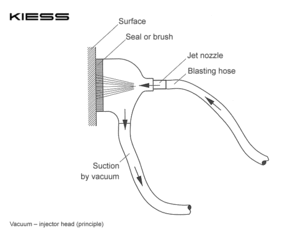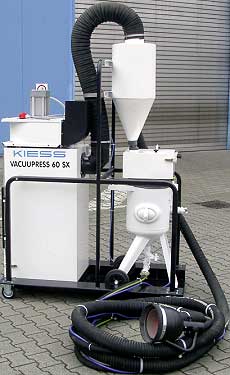2.2.3 Vacuum-compressed-air blasting and vacuum injection blasting
Compressed-air devices can be used as blasting devices to achieve high performances, and injection blasting devices can be used for more simple blasting work.
The blow head (outlet) the case of which seals completely the actual impact area from the surrounding is a typical feature of these systems. In general, the jet nozzle is in the centre of the blow head; this nozzle is provided with abrasive from a normal pressure pot with vacuum container placed on it as well as an integrated collector. After having impinged on the workpiece the abrasive is drawn back by the generated vacuum at the edge of the blow head and it is processed again.
The vacuum airstream for transporting the abrasive back can also be generated by separate vacuum facilities. This mainly applies to bigger plants where several blasting units work with that system at the same time.
It is, however, possible to connect more blasting units between blasting unit and vacuum facility according to the respective distance. The required vacuum is between 0.2 and 0.5 b.
Such systems can be used for any recyclable abrasive, e.g. chilled and steel casting granulate, electric-furnace corundum or glass beads, as well as for non-reusable abrasive.

Vacuum – injector head (principle)
Click to enlarge!
Cases of application could be reworking or smaller blasting processes where the used abrasive has to be collected immediately because the abrasive and the parts got off of the object to be blasted may contain toxic substances that have to be disposed separately.
The fact that this system operates under a closed cap (blow head) reduces decisively the performance. By this, the abrasive rebounding from the surface of the object to be blasted disturbs the abrasive flow leaving the nozzle. Part of the generated kinetic energy therefore neutralizes itself. It is also disadvantageous that it is not possible to monitor the just blasted surfaces.

Vacuum injector



